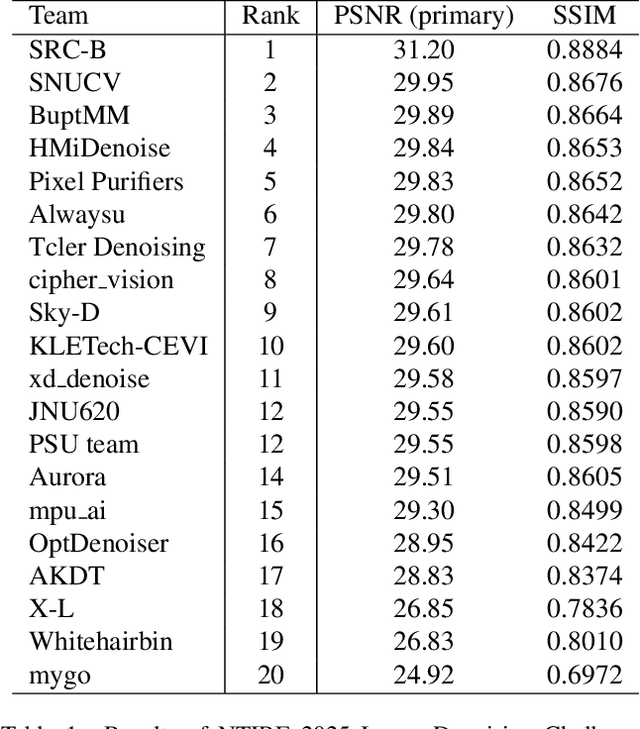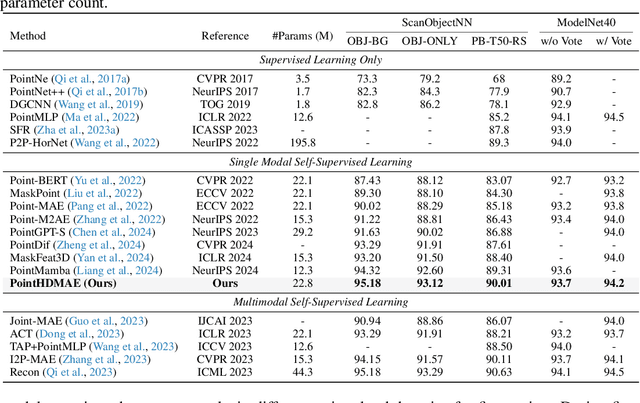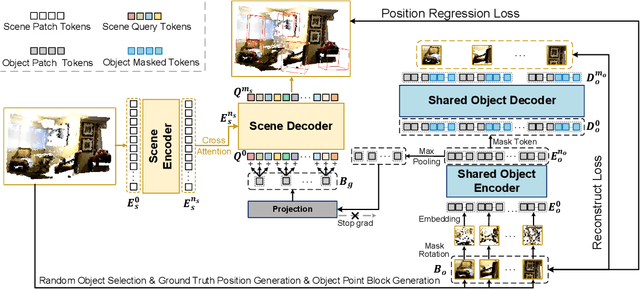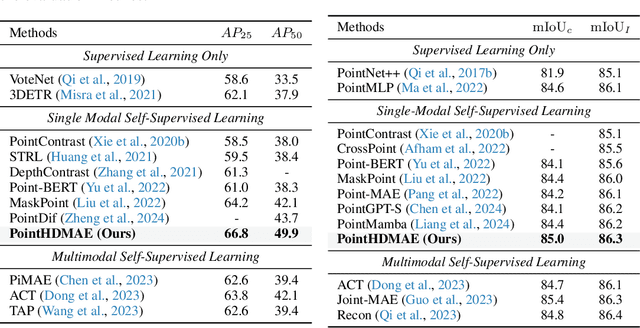Hang Guo
PMA: Towards Parameter-Efficient Point Cloud Understanding via Point Mamba Adapter
May 27, 2025Abstract:Applying pre-trained models to assist point cloud understanding has recently become a mainstream paradigm in 3D perception. However, existing application strategies are straightforward, utilizing only the final output of the pre-trained model for various task heads. It neglects the rich complementary information in the intermediate layer, thereby failing to fully unlock the potential of pre-trained models. To overcome this limitation, we propose an orthogonal solution: Point Mamba Adapter (PMA), which constructs an ordered feature sequence from all layers of the pre-trained model and leverages Mamba to fuse all complementary semantics, thereby promoting comprehensive point cloud understanding. Constructing this ordered sequence is non-trivial due to the inherent isotropy of 3D space. Therefore, we further propose a geometry-constrained gate prompt generator (G2PG) shared across different layers, which applies shared geometric constraints to the output gates of the Mamba and dynamically optimizes the spatial order, thus enabling more effective integration of multi-layer information. Extensive experiments conducted on challenging point cloud datasets across various tasks demonstrate that our PMA elevates the capability for point cloud understanding to a new level by fusing diverse complementary intermediate features. Code is available at https://github.com/zyh16143998882/PMA.
The Tenth NTIRE 2025 Image Denoising Challenge Report
Apr 16, 2025



Abstract:This paper presents an overview of the NTIRE 2025 Image Denoising Challenge ({\sigma} = 50), highlighting the proposed methodologies and corresponding results. The primary objective is to develop a network architecture capable of achieving high-quality denoising performance, quantitatively evaluated using PSNR, without constraints on computational complexity or model size. The task assumes independent additive white Gaussian noise (AWGN) with a fixed noise level of 50. A total of 290 participants registered for the challenge, with 20 teams successfully submitting valid results, providing insights into the current state-of-the-art in image denoising.
The Tenth NTIRE 2025 Efficient Super-Resolution Challenge Report
Apr 14, 2025Abstract:This paper presents a comprehensive review of the NTIRE 2025 Challenge on Single-Image Efficient Super-Resolution (ESR). The challenge aimed to advance the development of deep models that optimize key computational metrics, i.e., runtime, parameters, and FLOPs, while achieving a PSNR of at least 26.90 dB on the $\operatorname{DIV2K\_LSDIR\_valid}$ dataset and 26.99 dB on the $\operatorname{DIV2K\_LSDIR\_test}$ dataset. A robust participation saw \textbf{244} registered entrants, with \textbf{43} teams submitting valid entries. This report meticulously analyzes these methods and results, emphasizing groundbreaking advancements in state-of-the-art single-image ESR techniques. The analysis highlights innovative approaches and establishes benchmarks for future research in the field.
FastVAR: Linear Visual Autoregressive Modeling via Cached Token Pruning
Mar 30, 2025Abstract:Visual Autoregressive (VAR) modeling has gained popularity for its shift towards next-scale prediction. However, existing VAR paradigms process the entire token map at each scale step, leading to the complexity and runtime scaling dramatically with image resolution. To address this challenge, we propose FastVAR, a post-training acceleration method for efficient resolution scaling with VARs. Our key finding is that the majority of latency arises from the large-scale step where most tokens have already converged. Leveraging this observation, we develop the cached token pruning strategy that only forwards pivotal tokens for scale-specific modeling while using cached tokens from previous scale steps to restore the pruned slots. This significantly reduces the number of forwarded tokens and improves the efficiency at larger resolutions. Experiments show the proposed FastVAR can further speedup FlashAttention-accelerated VAR by 2.7$\times$ with negligible performance drop of <1%. We further extend FastVAR to zero-shot generation of higher resolution images. In particular, FastVAR can generate one 2K image with 15GB memory footprints in 1.5s on a single NVIDIA 3090 GPU. Code is available at https://github.com/csguoh/FastVAR.
Progressive Vision-Language Prompt for Multi-Organ Multi-Class Cell Semantic Segmentation with Single Branch
Dec 04, 2024



Abstract:Pathological cell semantic segmentation is a fundamental technology in computational pathology, essential for applications like cancer diagnosis and effective treatment. Given that multiple cell types exist across various organs, with subtle differences in cell size and shape, multi-organ, multi-class cell segmentation is particularly challenging. Most existing methods employ multi-branch frameworks to enhance feature extraction, but often result in complex architectures. Moreover, reliance on visual information limits performance in multi-class analysis due to intricate textural details. To address these challenges, we propose a Multi-OrgaN multi-Class cell semantic segmentation method with a single brancH (MONCH) that leverages vision-language input. Specifically, we design a hierarchical feature extraction mechanism to provide coarse-to-fine-grained features for segmenting cells of various shapes, including high-frequency, convolutional, and topological features. Inspired by the synergy of textual and multi-grained visual features, we introduce a progressive prompt decoder to harmonize multimodal information, integrating features from fine to coarse granularity for better context capture. Extensive experiments on the PanNuke dataset, which has significant class imbalance and subtle cell size and shape variations, demonstrate that MONCH outperforms state-of-the-art cell segmentation methods and vision-language models. Codes and implementations will be made publicly available.
MambaIRv2: Attentive State Space Restoration
Nov 22, 2024



Abstract:The Mamba-based image restoration backbones have recently demonstrated significant potential in balancing global reception and computational efficiency. However, the inherent causal modeling limitation of Mamba, where each token depends solely on its predecessors in the scanned sequence, restricts the full utilization of pixels across the image and thus presents new challenges in image restoration. In this work, we propose MambaIRv2, which equips Mamba with the non-causal modeling ability similar to ViTs to reach the attentive state space restoration model. Specifically, the proposed attentive state-space equation allows to attend beyond the scanned sequence and facilitate image unfolding with just one single scan. Moreover, we further introduce a semantic-guided neighboring mechanism to encourage interaction between distant but similar pixels. Extensive experiments show our MambaIRv2 outperforms SRFormer by \textbf{even 0.35dB} PSNR for lightweight SR even with \textbf{9.3\% less} parameters and suppresses HAT on classic SR by \textbf{up to 0.29dB}. Code is available at \url{https://github.com/csguoh/MambaIR}.
IntLoRA: Integral Low-rank Adaptation of Quantized Diffusion Models
Oct 29, 2024Abstract:Fine-tuning large-scale text-to-image diffusion models for various downstream tasks has yielded impressive results. However, the heavy computational burdens of tuning large models prevent personal customization. Recent advances have attempted to employ parameter-efficient fine-tuning (PEFT) techniques to adapt the floating-point (FP) or quantized pre-trained weights. Nonetheless, the adaptation parameters in existing works are still restricted to FP arithmetic, hindering hardware-friendly acceleration. In this work, we propose IntLoRA, to further push the efficiency limits by using integer type (INT) low-rank parameters to adapt the quantized diffusion models. By working in the integer arithmetic, our IntLoRA offers three key advantages: (i) for fine-tuning, the pre-trained weights are quantized, reducing memory usage; (ii) for storage, both pre-trained and low-rank weights are in INT which consumes less disk space; (iii) for inference, IntLoRA weights can be naturally merged into quantized pre-trained weights through efficient integer multiplication or bit-shifting, eliminating additional post-training quantization. Extensive experiments demonstrate that IntLoRA can achieve performance on par with or even superior to the vanilla LoRA, accompanied by significant efficiency improvements. Code is available at \url{https://github.com/csguoh/IntLoRA}.
BoostAdapter: Improving Vision-Language Test-Time Adaptation via Regional Bootstrapping
Oct 24, 2024



Abstract:Adaptation of pretrained vision-language models such as CLIP to various downstream tasks have raised great interest in recent researches. Previous works have proposed a variety of test-time adaptation (TTA) methods to achieve strong generalization without any knowledge of the target domain. However, existing training-required TTA approaches like TPT necessitate entropy minimization that involves large computational overhead, while training-free methods like TDA overlook the potential for information mining from the test samples themselves. In this paper, we break down the design of existing popular training-required and training-free TTA methods and bridge the gap between them within our framework. Specifically, we maintain a light-weight key-value memory for feature retrieval from instance-agnostic historical samples and instance-aware boosting samples. The historical samples are filtered from the testing data stream and serve to extract useful information from the target distribution, while the boosting samples are drawn from regional bootstrapping and capture the knowledge of the test sample itself. We theoretically justify the rationality behind our method and empirically verify its effectiveness on both the out-of-distribution and the cross-domain datasets, showcasing its applicability in real-world situations.
BoostAdapter: Improving Test-Time Adaptation via Regional Bootstrapping
Oct 20, 2024



Abstract:Adaptation of pretrained vision-language models such as CLIP to various downstream tasks have raised great interest in recent researches. Previous works have proposed a variety of test-time adaptation (TTA) methods to achieve strong generalization without any knowledge of the target domain. However, existing training-required TTA approaches like TPT necessitate entropy minimization that involves large computational overhead, while training-free methods like TDA overlook the potential for information mining from the test samples themselves. In this paper, we break down the design of existing popular training-required and training-free TTA methods and bridge the gap between them within our framework. Specifically, we maintain a light-weight key-value memory for feature retrieval from instance-agnostic historical samples and instance-aware boosting samples. The historical samples are filtered from the testing data stream and serve to extract useful information from the target distribution, while the boosting samples are drawn from regional bootstrapping and capture the knowledge of the test sample itself. We theoretically justify the rationality behind our method and empirically verify its effectiveness on both the out-of-distribution and the cross-domain datasets, showcasing its applicability in real-world situations.
Block-to-Scene Pre-training for Point Cloud Hybrid-Domain Masked Autoencoders
Oct 13, 2024



Abstract:Point clouds, as a primary representation of 3D data, can be categorized into scene domain point clouds and object domain point clouds based on the modeled content. Masked autoencoders (MAE) have become the mainstream paradigm in point clouds self-supervised learning. However, existing MAE-based methods are domain-specific, limiting the model's generalization. In this paper, we propose to pre-train a general Point cloud Hybrid-Domain Masked AutoEncoder (PointHDMAE) via a block-to-scene pre-training strategy. We first propose a hybrid-domain masked autoencoder consisting of an encoder and decoder belonging to the scene domain and object domain, respectively. The object domain encoder specializes in handling object point clouds and multiple shared object encoders assist the scene domain encoder in analyzing the scene point clouds. Furthermore, we propose a block-to-scene strategy to pre-train our hybrid-domain model. Specifically, we first randomly select point blocks within a scene and apply a set of transformations to convert each point block coordinates from the scene space to the object space. Then, we employ an object-level mask and reconstruction pipeline to recover the masked points of each block, enabling the object encoder to learn a universal object representation. Finally, we introduce a scene-level block position regression pipeline, which utilizes the blocks' features in the object space to regress these blocks' initial positions within the scene space, facilitating the learning of scene representations. Extensive experiments across different datasets and tasks demonstrate the generalization and superiority of our hybrid-domain model.
 Add to Chrome
Add to Chrome Add to Firefox
Add to Firefox Add to Edge
Add to Edge